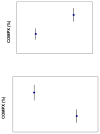A twin study of self-regulatory eating in early childhood: estimates of genetic and environmental influence, and measurement considerations
- PMID: 22249227
- PMCID: PMC4758446
- DOI: 10.1038/ijo.2011.258
A twin study of self-regulatory eating in early childhood: estimates of genetic and environmental influence, and measurement considerations
Abstract
Objective: Children differ greatly in their ability to self-regulate food intake for reasons that are poorly understood. This laboratory-based twin study tested the genetic and environmental contributions to self-regulatory eating and body fat in early childhood.
Methods: A total of 69 4-7 year-old same-sex twin pairs, including 40 monozygotic and 29 dizygotic pairs, were studied. Self-regulatory eating was operationalized as the percentage compensation index (COMPX%), assessed by a 'preload' challenge in which lunch intake was measured following a low- (3 kcal) or high-calorie (159 kcal) drink. Body fat indexes also were measured. The familial association for COMPX% was estimated by an intraclass correlation, and biometric analyses estimated heritability.
Results: Children ate more at lunch following the low- compared with high-energy preload (P<0.001), although variability in COMPX% was considerable. Compensation was significantly poorer among African American and Hispanic compared with European American children, and among girls compared with boys. There was a familial association for self-regulatory eating (ρ = 0.23, P = 0.03) but no significant genetic component. In all, 22% of the variance in COMPX% was due to shared environmental 'household' factors, with the remaining variance attributable to child-specific 'unique' or 'random' environments. Poorer self-regulatory eating was associated with greater percent body fat (r = -0.21, P = 0.04).
Conclusions: Self-regulatory eating was influenced by environmental factors, especially those differing among siblings. The absence of a significant genetic effect may reflect the age of the sample or could be artifactual due to measurement issues that need to be considered in future studies.
Conflict of interest statement
Figures

References
-
- Johnson SL, Krebs NF. Internal versus external influences on energy intake: are disinhibited eaters born or created? J Pediatr. 2009 Nov;155(5):608–609. - PubMed
-
- Birch LL, Deysher M. Conditioned and unconditioned caloric compensation: evidence for self-regulation of food intake by young children. Learning and motivation. 1985;16:341–355.
-
- Birch LL, Fisher JO. Development of eating behaviors among children and adolescents. Pediatrics. 1998 Mar;101(3 Pt 2):539–549. - PubMed
-
- Birch LL. The role of experience in children’s food acceptance patterns. J Am Diet Assoc. 1987 Sep;87(9 Suppl):S36–40. - PubMed
-
- Sullivan SA, Birch LL. Pass the sugar, pass the salt: experience dictates preference. Developmental Psychology. 1990;26(4):546–551.

